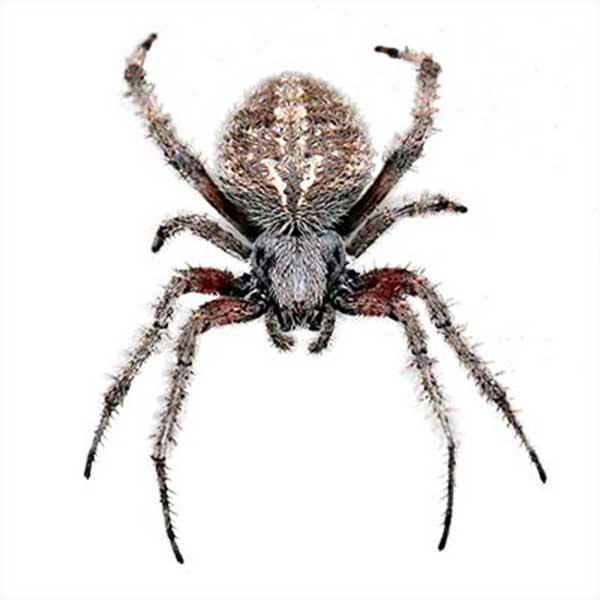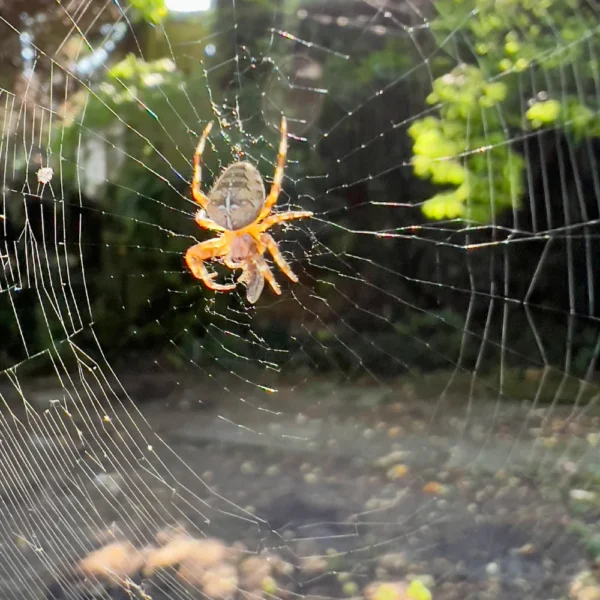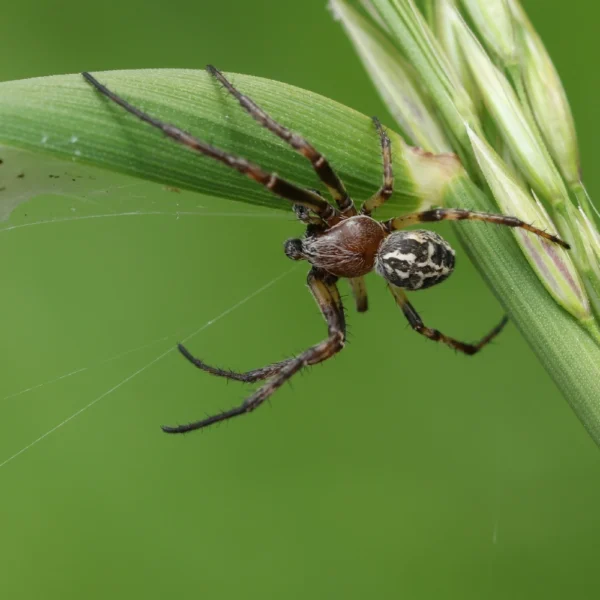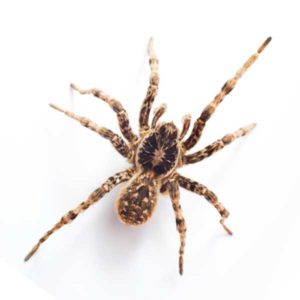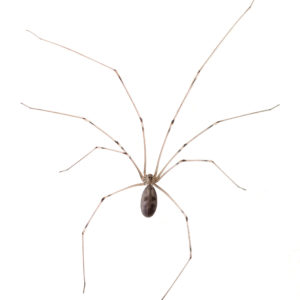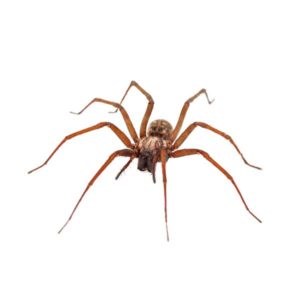The Orb Weaver or Garden Spider is the most recognizable arachnid in Florida, known for its intricate webs that glisten in gardens.
These spiders belong to the family Araneidae, which includes hundreds of species worldwide, many of which are found across the southeastern United States. Their beautiful and functional webs serve as highly effective traps for flying insects such as moths and mosquitoes.
You may encounter Orb Weavers around your home and in your garden often, but they are generally harmless and play an effective role in reducing pest insect populations.
If you know how to spot an Orb weaver and understand their behaviors, you can reduce unnecessary fear and find peaceful coexistence with these skilled web builders.
If you find that you have a large population of Orb weavers around your home and they are causing a nuisance, you can reach out to us at Florida Pest Control, and we can help you deal with the causes of the spider infestation.
Orb Weavers Spiders in Florida
With its warm temperatures and abundant vegetation, Florida’s climate provides an ideal environment for orb weaver spiders. Whether referred to as the orb weaver spider Florida residents notice in their backyards, or simply as garden orb weaver Florida species, these spiders are a familiar sight during late summer and fall when their webs become most prominent.
Florida orb weaver spiders are highly diverse, ranging from the brightly colored spiny orb weaver to the large, imposing golden silk orb weaver. Orb spiders in Florida construct webs in trees, shrubs, and the corners of man-made structures, where they can intercept a constant supply of insects. Their presence is often seasonal, with populations peaking in warm months when insect activity is at its highest.
While some homeowners worry about Florida orb weavers inside structures, these spiders prefer outdoor habitats. Occasionally, a web may be built near porches or windows, particularly where porch lights attract moths and other prey. Despite their visibility, orb weaver spiders rarely attempt to move indoors, preferring the open air and vegetation.
How to Identify an Orb Weaver Spider
Orb weaver spider identification is made easier by examining the spider and its web. The most distinctive feature of orb weavers is the circular, wheel-shaped web that often spans several feet in diameter. Unlike irregular cobwebs or funnel-shaped structures, orb weaver webs are symmetrical and carefully engineered.
Florida orb weaver spiders vary significantly in size and color, but most have large, rounded abdomens and relatively small heads. They are often brown or tan, usually marked with patterns that help them camouflage among leaves and branches. Some species, like the spiny orb weaver, have unique spiked bodies that make them easy to recognize.
The golden silk orb weaver, sometimes called the banana spider, can grow even larger than the average spider. Females can reach lengths of more than two inches.
Identifying an orb weaver spider also involves noting their behavior. These spiders often rest in the middle of their webs. During the day, they hide nearby in a retreat area. They wait for vibrations that signal captured prey. When disturbed, they may drop from their webs or retreat quickly to safety, but they are not aggressive toward humans.
Orb Weaver Spider Habitat
Orb weaver spiders’ habitat reflects their need for open space where large webs can be suspended. Gardens, wooded areas, and the edges of homes provide perfect locations for web construction. In Florida, orb weavers thrive in suburban areas. The bright lights draw in many flying insects, making it a perfect home for them.
Garden orb weaver Florida populations are among the most commonly encountered species in residential areas. They thrive in yards where vegetation and flowers attract pollinating insects, making gardens both hunting grounds and suitable nesting areas. These spiders may rebuild their webs nightly, recycling silk from the previous web to create a new one.
Orb weaver spiders build their webs outdoors. They often place them between branches, across pathways, or between fences and railings. Their habitat choice ensures a steady supply of prey like mosquitoes and moths. Indoors, sightings are rare. An orb spider inside a garage or shed has usually wandered in by accident rather than choosing it as a preferred habitat.
Florida’s warm and humid climate allows orb weavers to thrive for most of the year. However, their activity is most visible during late summer and fall. As temperatures drop, many orb weavers die off, leaving behind egg sacs that will hatch the following spring.
Are Orb Weaver Spiders Poisonous?
A common concern is whether orb weaver spiders are poisonous. Technically, orb weavers do have venom, as do most spiders, but it is designed for subduing their insect prey and is not considered medically significant to humans.
If bitten, which is rare and usually only occurs when a spider is accidentally pressed against skin, the effects are mild. A bite may cause slight redness or irritation like a bee sting, but orb weaver spiders are not dangerous. Orb weavers differ from venomous spiders like the black widow and brown recluse. They are harmless to both people and pets.
The intimidating size of some Florida orb weavers and their large, conspicuous webs often leads to unnecessary alarm. Knowing these spiders aren’t a threat can ease fear.
If you need spider control for your home or business, contact Florida Pest Control today for years of expertise and protecting Florida from the most nuisance pest.
Orb Weaver Spider Behaviors, Threats, or Dangers
Orb weaver spiders are great at precision and instinctive engineering. Many rebuild their webs nightly, removing damaged strands and recycling silk proteins to spin new, strong traps by morning.
They rely on these webs to capture flying insects such as moths, mosquitoes, and beetles. When prey becomes ensnared, vibrations alert the spider, which rushes to immobilize it with silk before consuming it. This hunting style allows orb weavers to control insect populations effectively.
Florida orb weaver spiders are generally docile and non-aggressive. They do not chase or stalk humans; when threatened, they are more likely to retreat or drop from their web than bite. Despite this, their sudden appearance at eye level or across walkways often startles homeowners and gardeners.
If there is any concern about Orb Weavers, it’s usually just a nuisance presence. Their large webs can block pathways or outdoor spaces, and their size can be intimidating, particularly when webs are built near entryways or porches. For businesses, visible orb weaver webs may create an impression of neglect, prompting commercial properties to seek professional spider management.
Orb Weaver Spider Frequently Asked Questions
How Big Do Orb Weaver Spiders Get?
Orb weaver spiders vary in size, but most adults measure between half an inch and one inch in body length, with leg spans that make them appear larger. Some Florida orb weavers, such as the golden silk orb weaver, can grow much bigger.
What Do Orb Weaver Spiders Eat?
They eat flying insects, such as moths, mosquitoes, and beetles, that become trapped in their webs, making them valuable allies in controlling insect populations.
How Long Do Orb Weaver Spiders Live?
Most orb weaver spiders live for about one year, with females laying eggs before dying in the cooler months. The egg sacs hatch in spring, continuing the life cycle.

